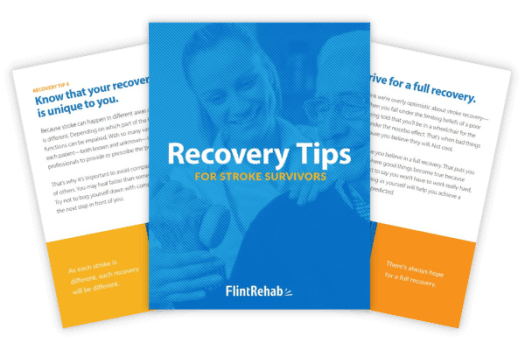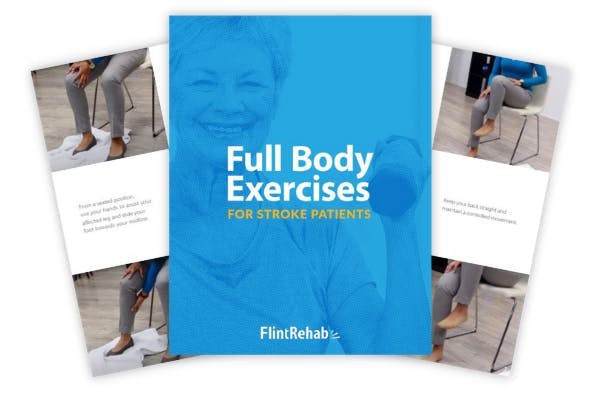No products in the cart.
No products in the cart.
No products in the cart.
No products in the cart.
Home » Neurological Recovery Blog » Stroke » When Survivors Can’t Swallow After Stroke: How to Recover from Dysphagia
Last updated on April 19, 2024

Over 40% of individuals struggle with swallowing or can’t swallow after stroke due to a condition known as dysphagia. Caused by difficulty controlling the oral muscles responsible for swallowing, dysphagia can result in serious complications, such as malnutrition or aspiration pneumonia.
This article will provide an overview of post-stroke dysphagia, including potential treatment options for those who can’t swallow after stroke. Use the links below to jump straight to any section:
Dysphagia is a condition characterized by difficulty swallowing. This is often as a result of impaired control over the muscles in the throat responsible for swallowing. There are two main types of dysphagia:
Oropharyngeal dysphagia can be caused by numerous neurological conditions, and is a common secondary effect of stroke. When a stroke damages the part(s) of the brain that control the throat muscles, such as the motor cortex or brain stem, the brain cannot accurately send and receive information from those muscles. As a result, this can inhibit the survivor’s ability to control the muscles necessary for swallowing, leading to dysphagia.
The severity of dysphagia ranges from minor difficulty with swallowing to the inability to swallow after stroke at all. Survivors with dysphagia may require alternative means of feeding, such as soft foods or thickened liquids. In severe cases, a feeding tube may be recommended.
Although dysphagia often improves within the first two weeks after a stroke, some individuals continue to experience swallowing difficulties for weeks to months after stroke. Pursuing rehabilitation can help maximize chances of long-term improvement and a return to normal swallowing function. However, if not addressed, dysphagia can lead to serious complications, which may be life-threatening.
For example, when the muscles of the throat and esophagus are not functioning properly, foods or liquids may enter the airway instead of being swallowed. This may cause bacteria to enter the lungs and cause infections, which can lead to aspiration pneumonia. In fact, compared to acute stroke survivors without dysphagia, those who do have dysphagia are over 4 times more likely to be at risk of developing aspiration pneumonia.
Malnutrition and dehydration may also occur if survivors can’t swallow after stroke. When individuals cannot eat or drink like they used to, they may choose not to eat at all. Furthermore, some survivors must only consume certain food textures or use thickening agents in their drinks, which can be unappetizing and contribute to meal skipping. In fact, studies estimate that around 20% of stroke survivors are malnourished, which is why it is so important to monitor nutrition closely.
Dysphagia can also increase the risk of choking. For the survivor’s safety, it is strongly recommended that all mealtimes are supervised by a caregiver or family member. While the individual is in the hospital following stroke, further safety recommendations are often made by a speech-language pathologist (SLP).
Due to the severity of these complications, among others, swallowing difficulties after stroke are taken very seriously by hospital medical teams. To reduce the risk of further complications, survivors with dysphagia should work closely with a speech-language pathologist to learn how to eat and drink safely after stroke.
Swallowing is a motor skill that many stroke survivors can relearn through rehabilitation. Using motor-specific rehabilitation methods, swallowing skills can improve, leading to improved nutrition and quality of life.
Due to their expertise in understanding the functions of the mouth, tongue, and throat, dysphagia is usually treated by a speech-language pathologist. An SLP may use the following interventions to help maximize the chances of regaining the ability to swallow after stroke:
Practicing swallowing exercises can help improve communication between the brain and the muscles involved with swallowing. While these exercises may not directly involve the act of swallowing, they can help train the associated muscles and improve oral motor control.
Consistently and repetitively practicing exercises related to swallowing can promote adaptive rewiring in the brain through a process known as neuroplasticity. When tasks are practiced regularly, neuroplasticity allows the brain to create and strengthen neural connections related to that task. This allows the brain to recover functions that were impaired or lost as a result of stroke-related brain damage.
Therefore, practicing swallowing exercises repetitively can stimulate neuroplasticity and encourage new neural networks to form, improving oral-motor function. With enough time and practice, this can maximize the chances of regaining the ability to swallow effectively.
While retraining the brain and the muscles to swallow is one of the most effective ways to regain the ability to swallow after stroke, recovery takes time. Until a survivor is able to swallow effectively, it is important to protect their safety by minimizing the risk of choking or silent aspiration (inhaling food or drink into the lungs without developing symptoms).
Here are some tips for survivors to consider to improve safety:
These compensation techniques can help protect safety as individuals continue recovering from stroke. While these are good generalized recommendations, please note that a speech-language pathologist will determine what textures of foods and liquids are safe at any given point in a survivor’s recovery.
They may initially recommend eating only pureed foods and thickened liquids before gradually introducing more textured foods as swallowing skills improve. Although speech therapists often trial new food textures in the clinic before upgrading their consistency recommendations, eating in a supervised area is strongly advised, especially when starting to eat new foods.
There are a few dysphagia treatments that are often recommended in addition to practicing rehabilitative exercises and utilizing compensatory techniques. These are generally not stand-alone treatments, but can enhance improvements when used in conjunction with other therapeutic techniques. These include:
When survivors can’t swallow after stroke, it is imperative to pursue treatment to ensure safety with eating and drinking and prevent complications. With guidance from a speech language pathologist, individuals can use one or more of the above treatments to improve swallowing after stroke. In addition to in-clinic treatments, survivors should continue safely practicing swallowing exercises at home to optimize neuroplasticity.
Although dysphagia is commonly experienced after stroke, over half of all acute stroke survivors with dysphagia recover within two weeks. However, every stroke is different and therefore recovery will be different for each individual. Furthermore, while dysphagia is often present initially after stroke, some survivors develop dysphagia later in their recovery.
More severe strokes tend to lead to more persistent dysphagia, depending on the location and size of the stroke. When dysphagia is severe, feeding tubes may be required initially to avoid malnutrition. These can be removed once swallowing ability improves.
At 6 months post-stroke, studies show only 5% of survivors with dysphagia require feeding tubes, while the vast majority of survivors regained the ability to swallow effectively. While each survivor’s stroke recovery timeline is unique, adherence to a consistent rehabilitation plan can maximize recovery.
When survivors can’t swallow after stroke, this is a sign of dysphagia. Dysphagia should be taken seriously as this can lead to other complications. Working alongside a speech-language pathologist essential. These specialists can diagnose any speech- or swallowing-related issues, suggest appropriate compensation techniques, and provide suitable exercises to help retrain the brain to control the oral muscles.
Recovery time varies from survivor to survivor. Some survivors regain the ability to swallow within the first two weeks after stroke, while others must pursue further rehabilitation to encourage the brain to rewire itself. With consistent practice, most individuals are able to regain the ability to swallow after stroke.

Get our free stroke recovery ebook by signing up below! It contains 15 tips every stroke survivor and caregiver must know. You’ll also receive our weekly Monday newsletter that contains 5 articles on stroke recovery. We will never sell your email address, and we never spam. That we promise.


Do you have these 25 pages of rehab exercises?
Get a free copy of our ebook Full Body Exercises for Stroke Patients. Click here to get instant access.
“My name is Monica Davis but the person who is using the FitMi is my husband, Jerry. I first came across FitMi on Facebook. I pondered it for nearly a year. In that time, he had PT, OT and Speech therapy, as well as vision therapy.
I got a little more serious about ordering the FitMi when that all ended 7 months after his stroke. I wish I hadn’t waited to order it. He enjoys it and it is quite a workout!
He loves it when he levels up and gets WOO HOOs! It is a wonderful product! His stroke has affected his left side. Quick medical attention, therapy and FitMi have helped him tremendously!”
FitMi is like your own personal therapist encouraging you to accomplish the high repetition of exercise needed to improve.
When you beat your high score or unlock a new exercise, FitMi provides a little “woo hoo!” as auditory feedback. It’s oddly satisfying and helps motivate you to keep up the great work.
In Jerry’s photo below, you can see him with the FitMi pucks below his feet for one of the leg exercises:
Many therapists recommend using FitMi at home between outpatient therapy visits and they are amazed by how much faster patients improve when using it.
It’s no surprise why over 14,000 OTs voted for FitMi as “Best of Show” at the annual AOTA conference; and why the #1 rehabilitation hospital in America, Shirley Ryan Ability Lab, uses FitMi with their patients.
This award-winning home therapy device is the perfect way to continue recovery from home. Read more stories and reviews by clicking the button below:
Grab a free rehab exercise ebook!
Sign up to receive a free PDF ebook with recovery exercises for stroke, traumatic brain injury, or spinal cord injury below: